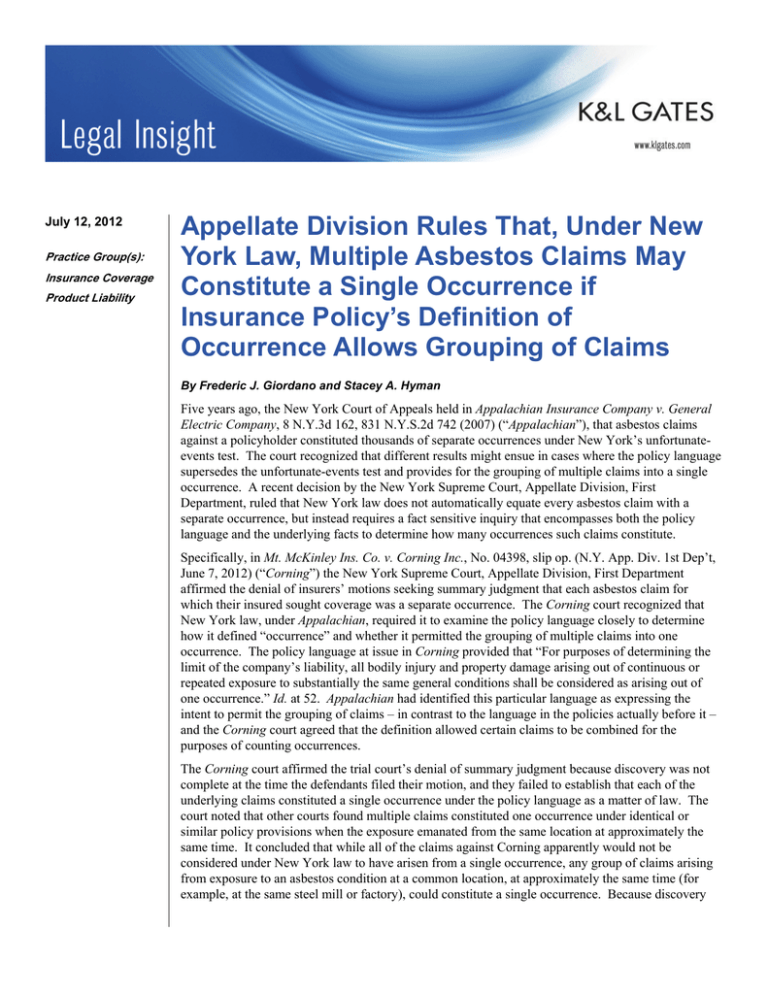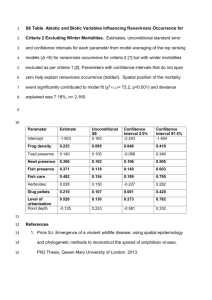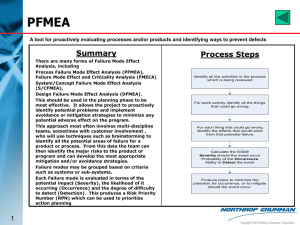Appellate Division Rules That, Under New Constitute a Single Occurrence if
advertisement

July 12, 2012 Practice Group(s): Insurance Coverage Product Liability Appellate Division Rules That, Under New York Law, Multiple Asbestos Claims May Constitute a Single Occurrence if Insurance Policy’s Definition of Occurrence Allows Grouping of Claims By Frederic J. Giordano and Stacey A. Hyman Five years ago, the New York Court of Appeals held in Appalachian Insurance Company v. General Electric Company, 8 N.Y.3d 162, 831 N.Y.S.2d 742 (2007) (“Appalachian”), that asbestos claims against a policyholder constituted thousands of separate occurrences under New York’s unfortunateevents test. The court recognized that different results might ensue in cases where the policy language supersedes the unfortunate-events test and provides for the grouping of multiple claims into a single occurrence. A recent decision by the New York Supreme Court, Appellate Division, First Department, ruled that New York law does not automatically equate every asbestos claim with a separate occurrence, but instead requires a fact sensitive inquiry that encompasses both the policy language and the underlying facts to determine how many occurrences such claims constitute. Specifically, in Mt. McKinley Ins. Co. v. Corning Inc., No. 04398, slip op. (N.Y. App. Div. 1st Dep’t, June 7, 2012) (“Corning”) the New York Supreme Court, Appellate Division, First Department affirmed the denial of insurers’ motions seeking summary judgment that each asbestos claim for which their insured sought coverage was a separate occurrence. The Corning court recognized that New York law, under Appalachian, required it to examine the policy language closely to determine how it defined “occurrence” and whether it permitted the grouping of multiple claims into one occurrence. The policy language at issue in Corning provided that “For purposes of determining the limit of the company’s liability, all bodily injury and property damage arising out of continuous or repeated exposure to substantially the same general conditions shall be considered as arising out of one occurrence.” Id. at 52. Appalachian had identified this particular language as expressing the intent to permit the grouping of claims – in contrast to the language in the policies actually before it – and the Corning court agreed that the definition allowed certain claims to be combined for the purposes of counting occurrences. The Corning court affirmed the trial court’s denial of summary judgment because discovery was not complete at the time the defendants filed their motion, and they failed to establish that each of the underlying claims constituted a single occurrence under the policy language as a matter of law. The court noted that other courts found multiple claims constituted one occurrence under identical or similar policy provisions when the exposure emanated from the same location at approximately the same time. It concluded that while all of the claims against Corning apparently would not be considered under New York law to have arisen from a single occurrence, any group of claims arising from exposure to an asbestos condition at a common location, at approximately the same time (for example, at the same steel mill or factory), could constitute a single occurrence. Because discovery Appellate Division Rules That, Under New York Law, Multiple Asbestos Claims May Constitute a Single Occurrence if Insurance Policy’s Definition of Occurrence Allows Grouping of Claims was incomplete, the Corning court ruled that a more fully developed evidentiary record was necessary to determine how many occurrences the underlying asbestos claims constituted. Corning underscores that calculating the number of occurrences for asbestos coverage claims under New York law is a fact sensitive analysis that turns on application of the facts to the policy language. It builds upon Appalachian by identifying specific circumstances in which asbestos claims might constitute one occurrence, under New York law, under a specific definition of occurrence. Policyholders facing asbestos claims with policies governed by New York law must recognize that no bright line rule exists, and then carefully review both the facts and the law when assessing how to maximize their insurance recovery. Authors: Frederic J. Giordano frederic.giordano@klgates.com +1.973.848.4035 Stacey A. Hyman stacey.hyman@klgates.com +1.973.848.4028 2


